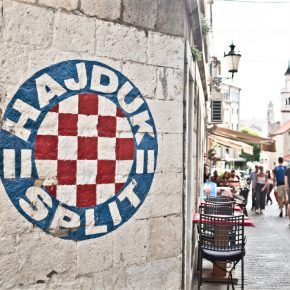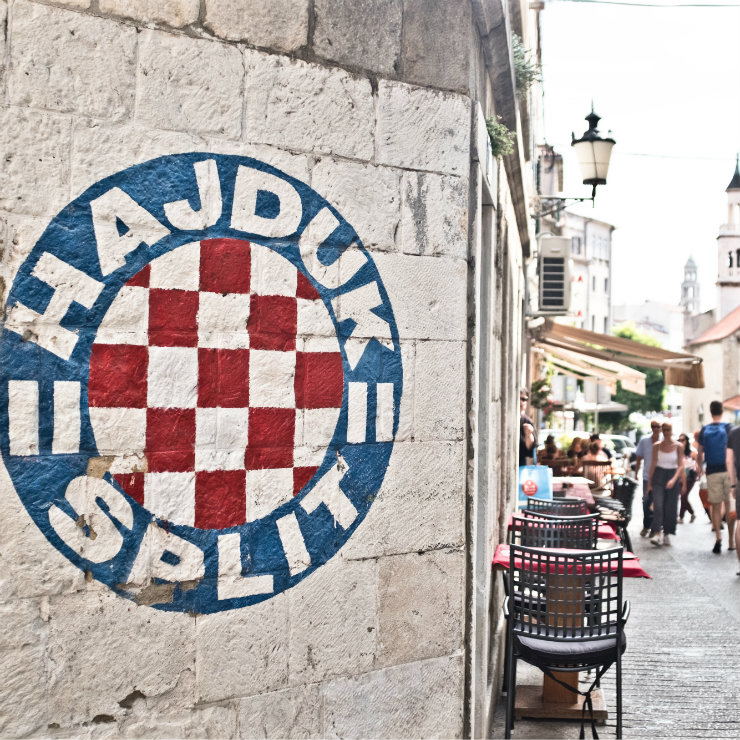
Split, Croatia (Marco Fieber, CC BY-NC-ND 2.0)
In 2011, European clubs made a net loss of EUR1.7bn, which means that in only six years the trend has shifted by as much as EUR2.3bn. This is the result of major changes occurring on the revenue side of football clubs, but also of the Financial Policy of the Financial Fair Play, which has compelled clubs to spend more than what they earn and to reduce their indebtedness since 2011. The number of profitable leagues has soared from 9 to 28 in just six years.
The good financial results are not evenly distributed across the continent, and is primarily a result of big profits in the largest European leagues (England, Germany, Spain, Italy). A good part of Europe still struggles with profitability. Croatia is in this second group of countries and its clubs in 2017 achieved one of the worst results in Europe with a negative net profit margin of over 30 per cent. Croatia is one of the few countries whose clubs have experienced a fall in revenues in the past financial year. This is due to the fact that no Croatian club played in the Champions League, so there was no inflow of additional EUR15m from UEFA on account of participation in this competition, as was the case in the 2016/17 season. In the so underdeveloped market and a lack for other sources of revenues (tickets, TV rights, sponsorships), a stumbling block or court error that may decide and (non) placement in the Champions League makes the difference between positive and negative financial results.
With football and its players, the media immediately binds the concepts of power, glory, women and money. But, nowadays, more talks are about the investments and the profitability of this industry. How to become and remain a successful manager in the largest global entertainment and sports industry? Why Forbes has been closely following for fifteen years and has published a list of twenty the most valuable football clubs and analyzed their profitability?
Twenty of the most valuable football teams in the world are worth USD1.69bn each. In just a year their value has grown by 14 per cent, and compared to 2013 by 74 per cent. In the era of low-interest rates, the slowdown in global economic growth and trade wars, this is an excellent financial result. But to make the whole system work, the players are needed. Without them, there is no business plan. This is where the football managers and agents come into the picture in an often-blurry story about the sordid global competition.
The final set-up of Croatian big three — made up of Dinamo, Rijeka and Osijek — is confirmed and the desired paradigm of governing the majority of Croatian football. Behind these clubs are usually owners with a foreign background, Italian-Nigerian or Hungarian, or American-German.
Almost nothing can globally affirm a country as much as a major achievement in the world’s most important competition — World Cup. Croatia has become a massive household brand in most of the world, almost like Coca-Cola or Marlboro, by joining the last year World Cup finals. The big world television broadcasts reporter teams reported on the finals from Zagreb, Zadar and Split. Since now everyone in the world knows about Croatia, and millions of people are reading about Croatia, and a percentage of World Cup fans will definitely decide to visit Croatia. Football is, therefore, the medium through which the Croatian Tourism Board is trying to promote country’s wine and gastronomy.
Revenues
In the financial year of 2017, Croatia’s top ten clubs had EUR42m of revenues, of which the largest part, up to 36 per cent, comes from UEFA, as an award on the basis of European competitions (Champions League and Europe League). Croatian clubs have made EUR15m (even without the placement of clubs in the Champions League), from which Rijeka has picked up 70 per cent of this amount through successful performance in the Europe League.
The second most important source of income of Croatian clubs is sponsorships, accounting for 34 per cent of total revenues (EUR14m), mostly done by national and multinational banks and corporations. Ticket revenue makes up just 10 per cent of revenues. TV rights account for just 3 per cent. Just for comparison, in England, that share is 54 per cent.
It should be noted that UEFA does not include transfers revenues in club’s total revenues, but rather leads them to profit from the sale of assets. When we compare the amounts of funds earned from the sale of players to the total club’s revenues it turns out that Croatian clubs are European leaders. Transfer revenues reach 117 per cent of total revenues. It means that through sales transfers they earned more than from all other sources of income — tickets, TV rights, sponsorships, sales of souvenirs, etc. The closest is Serbia with earnings from the transfer reaching 86 per cent of total revenues.
In the absence of high-quality stadiums, rather low attendance and the amount of TV rights, the business model of the Croatian Premier League was almost entirely relying on exporting talents, without which virtually no Croatian club could survive.
Infrastructure
So one of the goal is to change sports infrastructure. New investors are coming in, mainly from China. It is important to note that for China investments in sports is simply a way of achieving strategic goals, through an activity what is colloquially called the Chinese „stadium diplomacy”. China understands the attractiveness of sport and the way it enables diplomacy in international relations. In the last four decades, since the launch of stadium diplomacy, China has built or completely renovated over 60 stadiums around the world — most in Sub-Saharan Africa, then in Central America and the Caribbean, in Asia and the South Pacific. During the 1990s, this practice was significantly slowed down as China focused on its own consolidation, modernization and economic reform, and then in the last ten years has experienced a new big step.
Construction of stadiums is expensive and smaller economies are not able to finance such an investment single-handedly, while for China allocating EUR100m is not a problem. Croats should be aware that if the state accepts stadium construction either as a gift or through soft loans, China will expect something in return. In essence, China seeks resources and access to the European market.
Expenditures
The player’s salary is the biggest item in the expenses of football clubs, and in most European countries wages have increased. Other operating costs (the cost of organizing games, infrastructure maintenance costs, commercial costs, etc.) typically reach levels between 30-40 per cent of total expenses, the cost of wages may be even above 70 per cent. This is considered a risky strategy leading to losses. Since the Croatian clubs’ business model is highly export-oriented in terms of exporting talents, the clubs are driving on the wave of European growth in transfer prices. Croatian players benefited from Croatia’s entry into the European Union. Since then, they no longer have the status of an alien in the European leagues and no longer compete with South Americans, Africans and other pan-European players.
Such a business model, however, carries significant risks. It requires a continues education of young players to create a pool of internationally viable players, and any temporary stoppage in talent production can endanger the financial stability of clubs.
Vedran Obućina is an analyst and a journalist specializing in the Croatian and Middle East domestic and foreign affairs. He is the Secretary of the Society for Mediterranean Studies at the University of Rijeka and a Foreign Affairs Analyst at The Atlantic Post.


